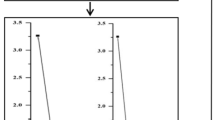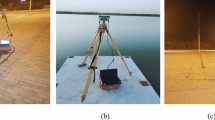Abstract
There has been a growing concern on how to monitor the operation conditions of flood discharge structure in recent decades. However, the online monitoring process is always interfered by ambient excitation which leads to inaccurate and uncertain structural characteristic evaluation. To mitigate the interference, a valid operation conditions monitoring method based on variance dedication rate (VDR) and permutation entropy (VDR-PE) is proposed. Firstly, a de-noising method combining wavelet threshold and empirical mode decomposition is used to remove heavy background noises, reducing the interference of ambient excitation to structural characteristic information. Then VDR method is used to realize the dynamic fusion of multi-channel vibration signals, extracting the vibration characteristic of the overall structure in an accurate and comprehensive way. Finally, permutation entropy is used to extract the entropy value of the fused signal. Through evaluating the operation conditions with coefficient of variation, the online monitoring of flood discharge structure can be realized. The effectiveness of permutation entropy algorithm on signal dynamic monitoring is validated by a simulation experiment. Furthermore, VDR-PE method is applied to Three Gorges dam to compare differences between analytical simulation and finite element simulation. The comparison results show that VDR-PE method can be applied to detect the dynamic changes and reveal the vibration characteristic of the overall structure accurately, which provides a new direction for the online monitoring of flood discharge structure.















Similar content being viewed by others
References
Zhang, J.W., Jiang, Q., Ma, B., Zhao, Y., Zhu, L.H.: Signal de-noising method for vibration signal of flood discharge structure based on combined wavelet and EMD. J. Vib. Control 23, 2401–2417 (2017)
Su, H.Z., Chen, Z.X., Wen, Z.P.: Performance improvement method of support vector machine-based model monitoring dam safety. Struct. Control Health 23, 252–266 (2016)
Shi, J.J., Liang, M., Guan, Y.P.: Bearing fault diagnosis under variable rotational speed via the joint application of windowed fractal dimension transform and generalized demodulation: a method free from prefiltering and resampling. Mech. Syst. Signal Process. 68, 15–33 (2016)
Ubeyli, E.D.: Recurrent neural networks employing Lyapunov exponents for analysis of ECG signals. Expert Syst. Appl. 37, 1192–1199 (2010)
He, Y.Y., Huang, J., Zhang, B.: Approximate entropy as a nonlinear feature parameter for fault diagnosis in rotating machinery. Meas. Sci. Technol. 23, 045603 (2012)
Widodo, A., Shim, M.C., Caesarendra, W., Yang, B.S.: Intelligent prognostics for battery health monitoring based on sample entropy. Expert Syst. Appl. 38, 11763–11769 (2011)
Pincus, S.M.: Approximate entropy as a measure of system complexity. Proc. Natl. Acad. Sci. 88, 2297–2301 (1991)
Zhang, L., Xiong, G.L., Liu, H.S., Zou, H.J., Guo, W.Z.: Bearing fault diagnosis using multi-scale entropy and adaptive neuro-fuzzy inference. Expert Syst. Appl. 37, 6077–6085 (2010)
Richman, J.S., Moorman, J.R.: Physiological time-series analysis using approximate entropy and sample entropy. Am. J. Physiol. Heart Circ. Physiol. 278, H2039–H2049 (2000)
Bandt, C., Pompe, B.: Permutation entropy: a natural complexity measure for time series. Phys. Rev. Lett. 88, 17–29 (2002)
Zhang, X.Y., Liang, Y.T., Zhou, J.Z., Zang, Y.: A novel bearing fault diagnosis model integrated permutation entropy, ensemble empirical mode decomposition and optimized SVM. Measurement 69, 164–179 (2015)
Vakharia, V., Gupta, V.K., Kankar, P.K.: A multiscale permutation entropy based approach to select wavelet for fault diagnosis of ball bearings. J. Vib. Control 21, 3123–3131 (2015)
Ferlazzo, E., Mammone, N., Cianci, V., Gasparini, S.: Permutation entropy of scalp EEG: a tool to investigate epilepsies: suggestions from absence epilepsies. Clin. Neurophysiol. 125, 13–20 (2014)
Sun, X.L., Zou, Y., Nikiforova, V., Kurths, J., Walther, D.: The complexity of gene expression dynamics revealed by permutation entropy. BMC Bioinform. 11, 607–621 (2010)
Tiwari, R., Gupta, V.K., Kankar, P.K.: Bearing fault diagnosis based on multi-scale permutation entropy and adaptive neuro fuzzy classifier. J. Vib. Control 21, 461–467 (2015)
Nicolaou, N., Georgiou, J.: Detection of epileptic electroencephalogram based on permutation entropy and support vector machines. Expert Syst. Appl. 39, 202–209 (2012)
Rao, G.Q., Feng, F.Z., Si, A.W., Xie, J.L.: Method for optimal determination of parameters in permutation entropy algorithm. J. Vib. Shock 33, 188–193 (2014)
Du, L.C., Song, W.H., Guo, W., Mei, D.C.: Multiple current reversals and giant vibrational resonance in a high-frequency modulated periodic device. EPL 115, 40008 (2016)
Dang, J., He, Y.Y., Jia, R., Dong, K.S., Xie, Y.T.: Detection for non-stationary vibration signal and fault diagnosis of hydropower unit. J. Hydraul. Eng. 47, 173–179 (2016)
Gao, J.B., Cai, H.Q.: On the structures and quantification of recurrence plots. Phys. Lett. A 270, 75–87 (2000)
Brown, C.E.: Coefficient of variation. In: Brown, C.E. (ed.) Applied multivariate statistics in geohydrology and related sciences, pp. 155–157. Springer, Berlin (1998)
Singh, H.P., Pal, S.K.: Estimation of population variance using known coefficient of variation of an auxiliary variable in sample surveys. J. Stat. Manag. Syst. 20, 91–111 (2017)
Jamesahar, E., Ghalambaz, M., Chamkha, A.J.: Fluid-solid interaction in natural convection heat transfer in a square cavity with a perfectly thermal-conductive flexible diagonal partition. Int. J. Heat Mass Transf. 100, 303–319 (2016)
Acknowledgements
This work was supported by the National Natural Science Foundation of China (Grant No. 51679091), the State Key Laboratory of Hydraulic Engineering Simulation and Safety of Tianjin University (Grant No. HESS-1312) and the Program for Science & Technology Innovation Talents in Universities of Henan Province (Grant No.18HASTIT012).
Author information
Authors and Affiliations
Corresponding author
Ethics declarations
Conflict of interest
The authors declare that there is no conflict of interest in preparing this article.
Rights and permissions
About this article
Cite this article
Zhang, J., Hou, G., Cao, K. et al. Operation conditions monitoring of flood discharge structure based on variance dedication rate and permutation entropy. Nonlinear Dyn 93, 2517–2531 (2018). https://doi.org/10.1007/s11071-018-4339-2
Received:
Accepted:
Published:
Issue Date:
DOI: https://doi.org/10.1007/s11071-018-4339-2




